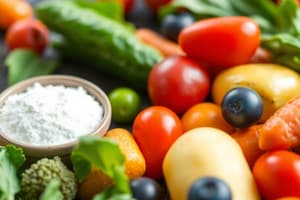Podcast
Questions and Answers
Which type of flour contains no less than 95% of the kernel?
Which type of flour contains no less than 95% of the kernel?
- Whole Wheat Flour (correct)
- Whole Grain Flour
- All Purpose Flour
- Enriched White Flour
Fresh vegetables are generally higher in nutrients than frozen vegetables.
Fresh vegetables are generally higher in nutrients than frozen vegetables.
False (B)
What are the two types of recommendations that make up the Dietary Reference Intakes (DRIs)?
What are the two types of recommendations that make up the Dietary Reference Intakes (DRIs)?
Estimated Average Requirements (EARs) and Recommended Daily Allowances (RDAs)
Folate is essential for the formation of ________ and protein tissue.
Folate is essential for the formation of ________ and protein tissue.
Match the following B vitamins with their primary functions:
Match the following B vitamins with their primary functions:
What is the recommended daily supplement dosage of folate for women of childbearing age?
What is the recommended daily supplement dosage of folate for women of childbearing age?
Overdosing on one B vitamin can mask a deficiency of another B vitamin.
Overdosing on one B vitamin can mask a deficiency of another B vitamin.
What condition is associated with folate deficiency that affects red blood cells?
What condition is associated with folate deficiency that affects red blood cells?
Which food sources are high in Vitamin B12?
Which food sources are high in Vitamin B12?
Folate deficiency can lead to megaloblastic anemia.
Folate deficiency can lead to megaloblastic anemia.
What is a common symptom of Vitamin B12 deficiency?
What is a common symptom of Vitamin B12 deficiency?
Vitamin D is essential for maintaining normal levels of minerals such as ______ in the blood.
Vitamin D is essential for maintaining normal levels of minerals such as ______ in the blood.
Match the vitamin with its function:
Match the vitamin with its function:
What can cause reduced synthesis of Vitamin D?
What can cause reduced synthesis of Vitamin D?
Vitamin D can be synthesized in the body without sunlight exposure.
Vitamin D can be synthesized in the body without sunlight exposure.
Name one group of people who are at risk of Vitamin B12 deficiency.
Name one group of people who are at risk of Vitamin B12 deficiency.
Which statement best describes the difference between vitamin fortification and vitamin enrichment?
Which statement best describes the difference between vitamin fortification and vitamin enrichment?
Fat-soluble vitamins can be removed from the body through urine when consumed in excess.
Fat-soluble vitamins can be removed from the body through urine when consumed in excess.
What are the daily dietary reference intakes (DRIs) intended to ensure?
What are the daily dietary reference intakes (DRIs) intended to ensure?
Vitamin ___ is often associated with preventing neural tube defects during pregnancy.
Vitamin ___ is often associated with preventing neural tube defects during pregnancy.
Match the B Vitamins with their roles:
Match the B Vitamins with their roles:
Which of the following vitamins is NOT classified as a fat-soluble vitamin?
Which of the following vitamins is NOT classified as a fat-soluble vitamin?
Excess intake of water-soluble vitamins carries a high risk of toxicity.
Excess intake of water-soluble vitamins carries a high risk of toxicity.
Name one factor that influences the bioavailability of vitamins.
Name one factor that influences the bioavailability of vitamins.
Flashcards
Enriched White Flour
Enriched White Flour
A type of flour that has had some nutrients added back after processing removes bran and germ.
Whole Wheat Flour
Whole Wheat Flour
Flour made from the entire wheat kernel, retaining most of the nutrients.
B Vitamins
B Vitamins
A group of water-soluble vitamins important for energy metabolism and cell division.
Folate (Folic Acid)
Folate (Folic Acid)
Signup and view all the flashcards
Neural Tube Defects
Neural Tube Defects
Signup and view all the flashcards
Dietary Reference Intakes (DRIs)
Dietary Reference Intakes (DRIs)
Signup and view all the flashcards
Spina Bifida
Spina Bifida
Signup and view all the flashcards
Estimated Average Requirements (EARs)
Estimated Average Requirements (EARs)
Signup and view all the flashcards
Water-Soluble Vitamins
Water-Soluble Vitamins
Signup and view all the flashcards
Fat-Soluble Vitamins
Fat-Soluble Vitamins
Signup and view all the flashcards
Vitamin Bioavailability
Vitamin Bioavailability
Signup and view all the flashcards
Essential Nutrient
Essential Nutrient
Signup and view all the flashcards
Micronutrient
Micronutrient
Signup and view all the flashcards
Organic Compound
Organic Compound
Signup and view all the flashcards
Toxicity
Toxicity
Signup and view all the flashcards
UL (Tolerable Upper Intake Level)
UL (Tolerable Upper Intake Level)
Signup and view all the flashcards
Megaloblastic Anemia
Megaloblastic Anemia
Signup and view all the flashcards
Folate Deficiency
Folate Deficiency
Signup and view all the flashcards
Vitamin B12 Function
Vitamin B12 Function
Signup and view all the flashcards
Vitamin B12 Digestion
Vitamin B12 Digestion
Signup and view all the flashcards
Vitamin B12 Deficiency
Vitamin B12 Deficiency
Signup and view all the flashcards
Vitamin D Synthesis
Vitamin D Synthesis
Signup and view all the flashcards
Vitamin D Functions
Vitamin D Functions
Signup and view all the flashcards
Vitamin D Deficiency
Vitamin D Deficiency
Signup and view all the flashcards
Study Notes
Vitamins Overview
- Vitamins are micronutrients needed in small amounts.
- They are essential nutrients, meaning the body cannot produce them.
- Vitamins are organic compounds containing carbon.
Learning Objectives
- Differentiate between water-soluble and fat-soluble vitamins.
- Understand the role of vitamins in health and disease.
- Learn how to plan a diet to meet vitamin recommendations.
Types of Vitamins
- Water-soluble: Absorbed into blood, not stored in the body. Supplies must be consumed regularly. Excess intake is removed by the kidneys via urine. Some still have toxic levels.
- Fat-soluble: Absorbed with dietary fat. Stored in the liver and fatty tissues. They can build up to toxic levels if consumed regularly in excess amounts, cannot be removed via urine.
B Vitamins
- B Vitamins (Water-Soluble): Thiamin (B₁), Riboflavin (B₂), Niacin (B₃), Pantothenic Acid (B₅), Pyridoxine (B₆), Biotin (B₇), Folic Acid (B₉), Cobalamin (B₁₂).
- Often grouped due to shared features.
- Essential for energy metabolism and cell division.
- Involved in protein and amino acid metabolism.
- Some are at risk in alcoholics.
- Can be dependent on each other.
Vitamin B12
- DNA/RNA/myelin sheath production.
- Bone metabolism, fatty acid production
- Found naturally in animal sources, nutritional yeast, and fortified foods.
- Requires intrinsic factor in the stomach for absorption.
- Deficiency can lead to pernicious anemia, nerve damage (numbness/tingling), and inflammation of the tongue.
- Uptake is often reduced in the elderly.
Vitamin E (fat-soluble)
- Protects cell membranes from oxidative damage.
- Protects against LDL oxidation.
- Protects vessels (mouth, larynx, esophagus).
Vitamin C (water-soluble)
- Protects cell membranes from oxidative damage.
- Protects saliva surfaces (mouth, larynx, esophagus).
Vitamin D (fat-soluble)
- Made in the skin through exposure to UV light.
- Essential in the diet when exposure to sunlight is limited.
- Important for calcium and phosphorus absorption.
- Needed for bone health.
- Found in fortified foods (milk and other dairy products, fish).
- Deficiency can lead to rickets in children, reduced calcium, and associated diseases.
Vitamin Bioavailability
- Bioavailability is the extent to which the body absorbs and uses a nutrient.
- Factors influencing bioavailability include absorption, transport in blood, and conversion of inactive forms to active forms.
Vitamin Functions
- Promote and regulate body processes for growth, reproduction, and maintenance of health.
- Act as coenzymes.
- Act as antioxidants protecting against free radicals.
- Do NOT provide energy itself.
Antioxidants
- Substances that protect cells from damage caused by free radicals.
- Free radicals can lead to cell damage and contribute to the development of diseases.
- Some foods naturally are antioxidants and others are marketed as such. They may provide some benefit but are not a cure-all.
Folate (Folic Acid)
- Helps form red blood cells and other proteins.
- Very important during pregnancy for neural tube development.
- Poorly absorbed from food but 100% absorbed from supplements.
- Deficiency leads to neural tube defects, such as spina bifida, and megaloblastic anemia.
- Recommendations for adequate intake, particularly for women of childbearing age.
Food Sources/Recommendations
- Importance of consuming a balanced and varied diet to obtain sufficient vitamins and other nutrients.
- Some sources are particularly rich in different vitamins.
- Recommendations in Canadian/American recommendations in various forms.
Vitamin Supplements
- Should be taken with caution as interactions and overdoses are possible.
- Can mask deficiencies if taken too much.
- Billions wasted on supplements where food intake is better and more holistic.
Studying That Suits You
Use AI to generate personalized quizzes and flashcards to suit your learning preferences.




